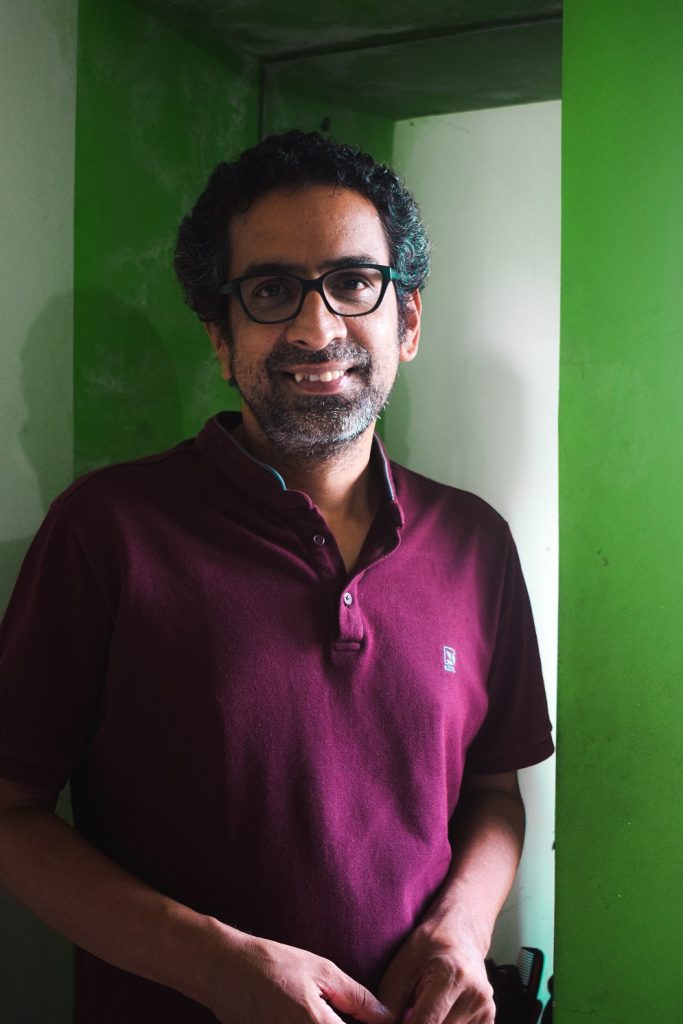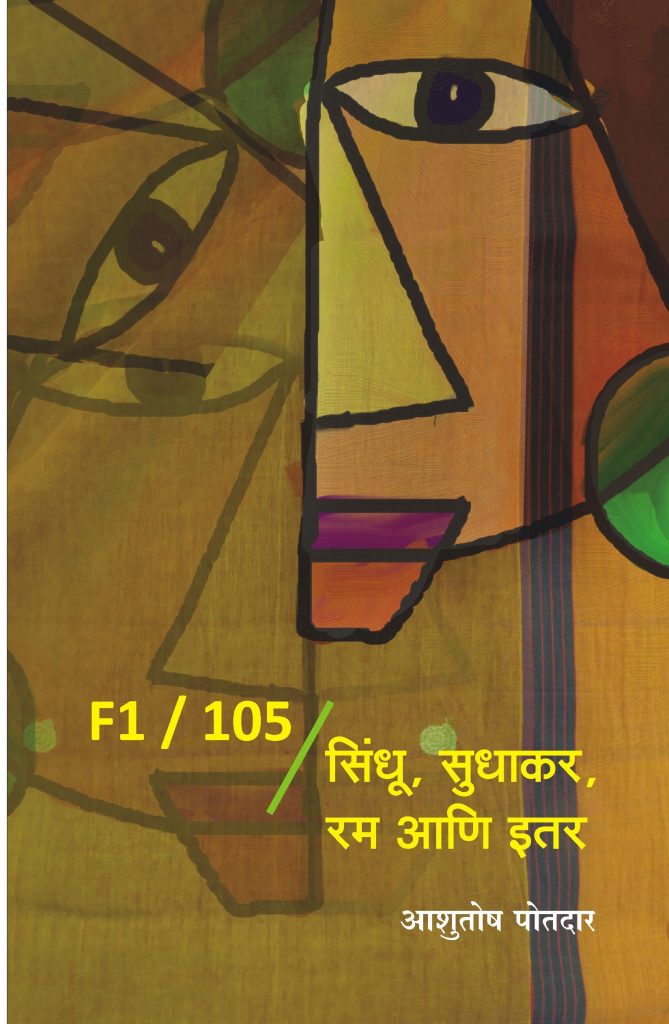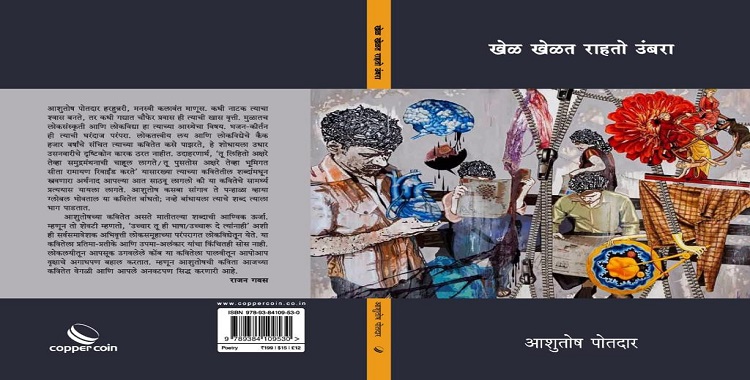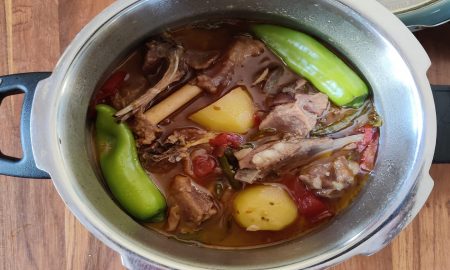Ashutosh Potdar, one of the significant names in contemporary Marathi experimental theatre, started writing when he was in college. Building a play line by line, scene by scene, engaging with characters, sounds, dialogues, art, sets apart a brilliant theatre from a mediocre one. All those who have read Ashutosh Potdar’s works and watched them on the stage can testify that he brings together all the artistic elements in one seamless whole. Interestingly, his poetic expressions and dramatic work go hand in hand, complementing and responding to each other. One of his biggest contributions to Marathi theatre and writing is his work in archiving and documenting its roots. He represents the contemporary generation of writers who, with their diverse perspectives of seeing the world and nuanced understanding of forms of expression, tell their stories.

When you look at Potdar’s oeuvre, what stands out is his exploration of the in-between spaces in people’s lives as he seeks the greys and examines the past through critical engagement and contemplation. The award-winning playwright and poet, who likes his plays to be provocative at all times, has an abiding interest in uncovering the layers of the relationship between partners—in marriage, amongst friends, and so on—exploring alternate forms of domesticity, sexuality, love. The researcher, as an outside voice, also keeps popping up in Potdar’s works.
However, for Potdar, the form of poetry is more personal. “Poetry is me talking to myself; till I find my own sound and until I find my own rhythm within a poem, I don’t stop.”
The poems in his recent collection, Khel Khelat Rahato Umbra, cover the landscape of his personal space from the past to the present and then expand to look beyond. Potdar’s friend, Mangesh Narayanrao Kale, a prominent Marathi poet, nudged him to bring out this collection of poems. Over the years, and especially during his college days, Potdar has been supported by writers, Rajan Gavas, Atul Pethe, Rafiq Suraj, and several others. His interactions with the late Govind Pansare, whom he met while living in Kolhapur, also deeply influenced him.
“This collection of poems was in progress for the last two decades or so. Kale trusted my writing. He connected me with the publisher, Sarabjit Garcha of Copper Coin, who brought out Khel Khelat Rahato Umbra. Kale helped me look at my collection because I never wrote the poems intending to publish them someday. You write because you have the urge,” explains Potdar, currently faculty of Literature and Drama at FLAME University, Pune.
Does he relive the urge when he reads his poems long after writing them?
“Yes, very much,” he says. “Memory plays a very important part in the writing process. It builds a connection, and you can also see how you are doing today, what are your views and ways of looking at life now as opposed to how it used to be earlier. Past is not just a moment; it’s a form. A poem on Mami Aaji, my grandmother, is about voices. I can still hear her. I grew up in a joint family, and the voices I heard in my childhood help me relate to the rhythm of the language, to the culture. In poems, I love exploring the naadbhasha.”
Potdar, who is the recipient of the Maharashtra Foundation’s R. C. Datar award, has written two poems on his grandmother; Mami Aaji: One and Mami Aaji: Two.
Mami Aaji: One
Khali var
Var, var
Satat, satat
Hussha Hussha
Padar mod
Dalan Kandan
Var khali
Bhar bhar
Mar mar
Say sutta
Jeev tod
Bhat bharan
Ikde tikde
Urka urki
Jag bhar
Nai kai
Giran gaon
Gaon jevan
Diwasbhar ajab kaam
Mayalu aay (aai)
Gaanari gai
Bolave kai
Bharli Mai
In this poem, he describes the familiar face of his grandmother as she breezes through the house with the pallu of her saree tucked into her waist: working herself to the bone, grinding lentils, storing rice grain, whipping up food for her family, guests, passers-by, with a smile on her face all the time.
Mami Aaji: Two
Potere lavun
Bhinta sarvun
Kharkharelya haatane
Chulitla nikhara
Cotwaril bedsheet neet karave
Evdhya phoolwaine
Rakhepasun bajula karaychis
Majgharatalya
Ujal andharat
Kawadshyanchya kirnanwar
Kalachi mojani karaychis
Renaissance la lajvelasha ghadyalane
Itaranchi radgaani
Tujhya padrawarlya
Maatkat rangavarna
Oghalaychi satat
Diwasbharachya gujagoshti
Aiklya nahit kadhi
Tujhya mhatarane,
Pan pandhrya bhintichya mahalatun
Avtaranari dhekane, jashi mogarbeeje
Rockel chimnichya prakashat
Tujhya padrachya akashakhali
Gujgoshti urus karaychi tujhyabarobar
Aispais pasarlelya tujhya pilawalinsathi
Swatahache dablele ussase chimtit pakdaychis
Pilwatun gelelee gaatre ukhalachya khol paatalat
Khuntila latkavun yaychis
Tujhya parantwandanchya
Vahiwarla spiderman
Aata jaale pasartoy
Udi maraysathi sajjay
Tyachya netchya harek nasecha dhaga
Paatalat khuntiwar latkavlelya
Gaatranchya mogarmayet shirun
Chandravar visavnarya
Tujhya kharkarit haatakade zhopavtoy.
Here the poet describes his grandmother plastering the walls of their house with cow dung, straightening out the crinkles on the bedsheet. He talks about how she would be alone in the kitchen, keeping time to the passage of the sun, her pallu holding the tears that she had wiped off from many faces. But when it came to sharing confidences, Mami Aaji wouldn’t talk with her old man. Instead, she would have a heart to heart with the bedbugs in the light of the flickering kerosene-lit lamp. Not one to air her sorrows, she would leave them to hang out on the clothesline, while a child of hers plans to return home.
Undoubtedly evocative with a strong element of drama, Potdar’s poetry collection is genre and label defying. Potdar takes the readers through his reminisces about family, the games that they played, while also describing the countryside and creating a vivid atmosphere of greens, blues and dried yellow, as in the poem titled Nakshatra. Whether it is his cheeky and sly humour in A Poem on Kujke Diwas, or his attempt to make sense of where he belongs in Tumhi Ithe Ahat to Melela, Tyache Atmakathan, not one poem or subject it touches upon is similar to the other. The verses succeed in confounding you, teasing you, reminding you of your own attachments to your grandmother, cousins, ancestral village, before disappearing off in a whiff of stark observation. The poet also introduces the reader to the complex web of relationships and the tensions brimming underneath the changing socio-cultural contexts. This is evident in his sharply written four-line poem My Curly Boy.
Originally from Kasaba Sangaon in Kolhapur district, Potdar didn’t begin writing formally until he started college. “I was studying in Kolhapur, and then I began writing as any other student would—contributing to the college journal, wallpaper, competitions. I wrote poems and short stories. I began writing plays for the inter-collegiate drama competitions and then directing them when I was teaching in Ichalkaranji,” he says.
His exposure to art forms, however, began early in life, in his childhood. “My grandfather was a Warkari, bhajankari, a bhajan singer. (A Warkari is someone who undertakes the annual wari (pilgrimage) to Pandharpur, the main center of Vitthal sect or Warkari sect. They also undertake similar waris to the Samadhi sthala (resting places) of saints such as Dnyaneshwar, Tukaram, Muktabai and Eknath). He had a bhajan mandal, and he would take me everywhere for the bhajans. As a child, I would love to sit through a bhajan, not overnight, but until I got a cup of tea! I would hold a veena until the end of panchapadi (five abhangas) and take a few small steps while chanting the name of Vithoba-Rakhumai. Around 15-20 people lived together in our family home, and everyone around me was a storyteller. I heard stories at a haircutting salon, at a katta under a huge pipal tree, in local folk performances. Babumama, who ran a hair cutting salon in my village, had a performance group playing Sangya Balya, a folk form from the Maharashtra-Karnataka border region. He would play the comic character of Sangya, and he would provoke us, in his inimitable and energetic style, to be part of his performance and invite us kids (as well as adults) to rediscover the world.”
Potdar’s writing is rooted in the traditions and socio-political ethos of our land, but at the same time, it also strives for an-all-encompassing global view. Potdar, who has taken training in Yakshagana, a traditional form of dance-drama, under famed gurus, says, “I come from a folk tradition background, but I have also been shaped by the cosmopolitan atmosphere in the cities. There is always that insider-outsider perspective that helps my work. When you are working at the local level, you don’t get perspective, but when you move to a larger playing field, away from your folks, the distance, the bird’s-eye view helps. What is important is to question. In folk art form, sometimes the jokes narrated are cheap, the sutradhar is an important aspect, but he can also be manipulative. In cities, the cafes, for instance, are a treat as they offer dynamic cultural view within the multilingual environment. But they can also drag your attention to capitalist extravagance. I would wonder why the staff there talk only in English and not in other languages.”
In Kolhapur, he was fascinated by the activities around Dasara Chowk, a junction in the city. He reproduced his observations of the comings and goings at the junction in his plays and stories about migrants, transition, the desire to be somewhere else without knowing what one wants or where to find it. This is reflected in his plays like Anandbhog Mall and Pulakhalcha Bomblya Maruti. Potdar, who has worked, lived and travelled to several cities and towns, says that he has always experienced a conflict between belonging and disconnectedness.
“When you are in Pune, you are a part of Pune culture, but at times you are disconnected. Sometimes you feel you belong, other times you feel you are barely holding on. Some days you are frustrated, not knowing what exactly you want, you are on a constant search. You feel that life is elsewhere, but where is that, you don’t know. There is always an in-between game, a tension between the rural and urban, between traditional and urban lifestyles, home and outside of the home. I hold on to this threshold image, the umbra (Marathi for threshold), where I often find myself.”
Potdar, who worked as the Programme Officer at India Foundation for Arts (IFA), Bengaluru, wrote his play F1/105 after reading a poster on the noticeboard of his apartment complex that invited residents to take part in Dasara (Dushhera) programmes. “Bengaluru has a dynamic speed. On the one hand, you are in a cosmopolitan, multicultural environment. Your neighbours could be someone from Bihar or Chennai. And on the other hand, you also have places like Malleshwaram, where people speak only Kannada. The multiple facets of the landscape captivated me. The cosmopolitan spaces in Bengaluru would be very liberal, but when Bengalis met, they started talking their language, embracing their Bengali-ness. Likewise, for Marathi people. I wanted to explore this control of our society, and that’s how I came up with this idea of F1/105,” he explains.
The play, directed by Mohit Takalkar for his theatre group Aasakta Kalamanch, focuses on a couple, Mumu and Sagar, who were planning to decorate their house in green colour.
“In F1/105, the characters own the flat. But they are told by seen and unseen powers around them how to use their space, engage with it. (Ganesh Chaturthi was around the corner, and Mumu and Sagar wanted to paint one room in green colour). I wanted to explore the aesthetics of the colour and the politics behind it. We did some exercises beyond the theatre space. We wanted to see the reactions of people in the public domain—what the colour meant to ordinary people. Their findings helped the team to realise the sentiment behind the play,” says Potdar.
At IFA, Potdar’s work involved studying and evaluating proposals besides monitoring the work supported by the organisation. He says that the work was exciting. It gave him the chance to travel extensively across India, talk to artists, organisations, theatre groups, watch plays, and hold discussions about art, funding and different concerns that were plaguing people in the arena. Potdar turned his experience of working on one such art residency into the play Pulakhalcha Bomblya Maruti.
“I wrote Pulakhalcha Bomblya Maruti when I was in Bengaluru. As a part of my job at IFA, I was working on various residency formats and that was the time I could look dynamically at the relationship between art and society. I was pondering over the engagement of an art/artist with the world around them, the sound around the art in the public domain and how an artist goes beyond it,” observes Potdar.
While he was at IFA, he met Alok Rajwade (actor-director and one of the founding members of Natak Company, a Pune-based theatre group) who was working on a project there.

Later, when he moved to Pune, Potdar wrote the script of Sindhu, Sudhakar, Rum Aani Itar, an experimental Marathi play, for Rajwade’s Natak Company. It revisits the old classic and very popular Marathi play Sangeet Ekach Pyala (a Sangeet Natak) by Ram Ganesh Gadkari (1885-1919).
“Alok (Rajwade) and Omkar (Govardhan), from the Natak Company, suggested that I should work on Ekach Pyala (The last drink). But several people had already done Ekach Pyala. I said maybe we could revisit it from another angle, which would allow us to look back at our own glorious past,” says Potdar.
Rajwade agreed, excited by Potdar’s vision to revisit the play through the lens of two female costume designers working on a period film based on the drama Ekach Pyala.
Sindhu, Sudhakar, Rum Aani Itar, which opened the prestigious Vinod Doshi Theatre Festival in Pune in 2016, is a play within a play. Two costume designers, Rama and Apple, depict the story in the present even as their tailor, Inder, watches and measures their lives against that of two couples—Sindhu and her alcoholic husband, Sudhakar, and his drinking buddy, Taliram and his wife, Geeta.
Potdar says, “I created Sindhu rooted in Sangeet Natak tradition but I also created the cosmopolitan character of Apple. They are both from a particular time frame, but you bring them together, get them to face each other and create complexities around them. I wanted to find out if I could create stereotypes, remove the character from one context and put them in other to create a magical world. Would the stereotypes still work? I considered that to be an experiment.”
Regarding the iconic character of Taliram, Potdar explains his vision, “In middle-class Marathi households, alcohol is considered an unethical and immoral act. The elders would warn, tuzha Taliram hoil haan (Stay away from alcohol, or you will become Taliram, a drunkard). I am also a part of such a household; I love rum (Old Monk), and I was interested in how the act of drinking creates a space to engage with other people. After drinking, you develop a keen interest in your own world; I wanted to explore that moment of intimacy, the moment in which you are living, having forgotten everything else—the hungover space created by alcohol. I wanted to use it as a metaphor for the thought—‘you are actually nowhere, but you are somewhere’. The crux of Ekach Pyala was Sindhu’s suffering, but what intrigued me was the subtle relationships between Taliram and Geeta and Sudhakar and Sindhu.”
Gadkari’s play is known for its literary quality, and in the portions from the original play retained in Sindhu, Sudhakar, Rum Aani Itar—thecharacters speak the text, whereas the present-day characters’ converse in a dialect, not adhering to praman bhasha or the standard language.
“The play unfolds at three levels. One level is the language from Gadkari’s era, another is at the contemporary level, and the third responds to both. We are approaching the play from our point of view, so that’s why the language would be ours, the form would be ours, and so also the technique. When we are talking of past and contemporary, it’s not only about location, it’s about language, certain mannerisms—the saree draping scene in the play, where Rama and Apple discuss the texture of the fabric and ponder over how Balgandharva (the singer-actor who played the role of Sindhu) would have draped it—we wanted to explore all these possibilities through the act of performance. The act of performance comes with the language. The language should be of the character. Another aspect was that we wanted to have a critical approach for the play, which was not happening in Marathi films or theatre at that time (Around 2016-19, many biopics on theatre personalities and period films on Sangeet Natak were released). We wanted to respond to Ekach Pyala in a contemporary context. Gadkari saab was great, Balgandharva was great, so why not show our appreciation through criticality? Why stop at only glorifying the past?” says Potdar, who has also won the Maharashtra government’s Ram Ganesh Gadkari award.
When he was writing Sindhu, Sudhakar, Rum Aani Itar Potdar was fascinated with the mannequins in the play-making process, the mangalsutra and the saree. He was keen on exploring the use of mannequins on the stage. The stage act of dressing a mannequin in a saree and connecting it to the material culture of the Sangeet Natak era was a way of engaging with tradition and society. This interest in learning more about the material history of the dramas and archiving them is the playwright’s area of focus.
Potdar has written a play, Sadasarvada Purvapaar (2019), on the role of research and archiving, which was performed by drama students of Lalit Kala Kendra Gurukul, Savitribai Phule Pune University.
Along with Sharmistha Saha, Professor of Literature and Drama at IIT, Powai, Potdar is working on a non-fiction book that documents performance archive. The collection of essays, which Routledge will bring out this year, looks at the relationship between performance making and the archive. Potdar explains, “When we look at the history of Marathi theatre, we tend to think of Sangeet Natak. But there were also jalsas, and the rich traditions of powada, lavani, tamasha. We need to analyse different forms, look at the material existing on colonial Marathi theatre, what kind of translations were done of (William) Shakespeare’s writing.”
It is widely believed that Vishnudas Bhave is the father of modern Marathi theatre in the 19th and 20th century. “One believes that Bhave was the first theatre artist who is known to have introduced newer ways of presenting plays. What we have to understand is that it wasn’t Bhave alone whom we can talk about when it comes to the origin of theatre. I have been researching the origin of theatre. Where do you see it? Where does its modernity lie? Is it in the practice? Is it in the writing, or is it in the entire discourse that surrounds modernity,” Potdar asks before adding, “Several people have contributed to the making of modern theatre. Serfoji Raje Bhosale, the King of Thanjavur, also did theatre. One of his plays, Lakshmi Narayan Kalyan, was written in Telugu, Tamil, Marathi. Social reformer Mahatma Jyotiba Phule had written Tritiya Ratna. When we talk of modern Indian theatre, we take references from Western theatre. The point of this research is that we should also look at our own regional resources.”
Potdar has created an archive of the material from the 19th and 20th century period of Marathi theatre and has evaluated it. He says that such material would help in understanding not only Indian theatre history but also how cultural evolution took place. “You can reimagine performances through archival material like tickets etc.,” he says.
History, Potdar believes, has multiple directions. “History keeps moving, shifting, and it depends on how we approach it.” In his play Anandbhog Mall (performed in 2009), he takes a searching look at the relationship between two castes, who have been rulers and held positions of privilege in Maharashtra.
“Caste and territorial conflict also interest me, but I approach this subject via relationships. In 2004, Bhandarkar Oriental Research Institute (BORI) in Pune was vandalised by Sambhaji Brigade (the activists of Sambhaji Brigade were acquitted in 2017 by Sessions Court in Pune). I am not equipped to analyse the politics of the attack on BORI. I am a writer, so I wanted to find out what happens to these two castes who have always enjoyed power, what happens to the relationship between them. That was also the period of Mallika Sherawat and the movie, Murder, the MIDC (Maharashtra Industrial Development Corporation) zone that was arising around Kolhapur, and the migration from villages to cities. Caste is not vague; it’s about skin colour, the way you speak, the food you eat. It’s a social construct. All these factors build up Anandbhog Mall, in which a Maratha doctor and a Brahmin Sociology lecturer get married. These characters are ‘liberal’ and are engaged in different social activities, but when it comes to space or intimacies, they are being controlled by their caste identity. Intimacies talk about deep-rooted anxieties, body, physicality which I wanted to bring about in the play,” elaborates Potdar.
Takalkar, who has directed Potdar’s F1/105 and Anandbhog Mall, says, “Ashutosh’s writing is firmly rooted in reality but also incorporates elements of fantasy. Anandbhog Mall is no exception. It’s entrenched in traditions – rural life on one hand, and on the other, the characters were trying to seek the new.”
Potdar, who is currently working on an anthology of The Greatest Marathi Stories Ever Told for Aleph Book Company, says that he wouldn’t be able to write a play like Anandbhog Mall again. “Caste strife has become more complex, dense. It’s difficult to capture all this in the format of a play. Maybe that’s my limitation. At the moment, I am more in tune with narrative form,” he says.
In the lockdown period, since no one knows when theatres can resume operations, Potdar is writing poems. “I write and publish on my blog,” he says. He’s also engaged in bringing out Hakara, a bilingual online journal in Marathi and English. “I am in close touch with several institutions, people, learning more about different forms. I wanted a platform to engage with different forms of creative expression. I reached out to Noopur Desai, who comes from a visual arts background to join the project. That was the beginning of Hakara four years ago. Hakara focuses on visual arts, performing arts, we also do translations from English to Marathi and vice versa, and some critical engagement with different forms,” he says.
At Hakara, they don’t mentor their contributors per se, but there is an interaction with the writers who send their submissions. “We ask them questions, we have discussions, address their concerns if they have any, and help each other. When we announce a theme for the next edition, we ask for suggestions,” informs Potdar.
Those who contribute to Hakara come from diverse linguistic and practice backgrounds. They are writers, poets, performance artists, visual artists, from different localities in India and abroad. There has always been a dichotomy of Gramin Sahitya (lit. rural/countryside literature) and writing focused on urban areas.
Are the lines blurring now?
“Yes, it is blurred and also mixing now. There is Wi-Fi across cities and villages, and Facebook and WhatsApp have a wide presence even in rural areas. Hakara travels across boundaries, regions. Our writers are not only from cities but also from villages and small towns across the country and also abroad. For instance, in the recent edition, we have had Krishnat Khot, who writes Gramin Sahitya in Marathi,” Potdar says.
Through Hakara, Potdar and Desai hope to prod readers to explore a deeper engagement with the worldviews and understanding put forward in various forms. “There used to be long poems, but now hardly anyone writes in that form. Poets are now aware of the short attention/time span of the readers. That I think is a crisis. We have told some of our contributors not to send us social media type of writing but to send elaborately presented writing like ‘Khayal’ genre in music.”
“When it comes to poetry, you never really stop or conclude. One poem follows the other; you are never satisfied. But you don’t rework it. In plays, you need a logical end because the play has a team, a system, and it has to wrap up in 90 minutes.”
This ability to straddle various formats that offer contemplative, nuanced responses to socio-political triggers is a distinctive feature of Potdar’s oeuvre. In his collaborator, Takalkar’s words, “In Marathi theatre, we have always had a baggage, of the standards set by Vijay Tendulkar, Satish Alekar, Mahesh Elkunchwar, Go Pu Deshpande and others. New writers are often compared to as having Tendulkar style or Alekar style. Ashutosh comes from a small town; he has seen life closely from a different angle, and has travelled, lived and worked in Bengaluru and other cities. All these realities come together in his plays seamlessly. He doesn’t write to impress.”
As a writer, Potdar responds to broader contexts with his tools of characters, real people, relationships to respond to what is happening in the broader social canvas. Says he, “In Pulakhalcha Bomblya Maruti, I was interested in the subtleties of relationships that develop between the characters when they are placed in different contexts, for a certain period and certain reasons. In Anandbhog Mall, I experiment with the space that is the tiny bedroom. The starting point is a relationship, but it is how I want to respond, address the concerns that I have about form, societal structure.”
Potdar diligently works with form by introducing fantasies of characters living in an intimate space (Anandbhog Mall), soundscapes and musical compositions (street-plays and Pulakhalacha Bomblya Maruti), role-playing and re-imagination of chorus (Sadasarvada Purvapar and F1/105). Language plays a vital role in Potdar’s writings. He brings in different dialects of the Marathi language in its historical as well as contemporary formations.
Potdar is comfortable both in a CCD cafe, scratching at what lies beneath the surface of the homogenised ambience and at a chai tapri in Kasaba Sangaon, where the realities of life are starker. What is common is his balanced questioning of the traditions of folk art and modern institutes. “There is capitalism, and there is faith, beliefs. There should be no extremes of either urbanisation or retaining a rural way of life. The caste system is entrenched in villages, and the cities are decaying. We have to look for a middle ground that gives us happiness, strength. More than dystopia, I prefer utopia,” he says on a concluding note.
***





